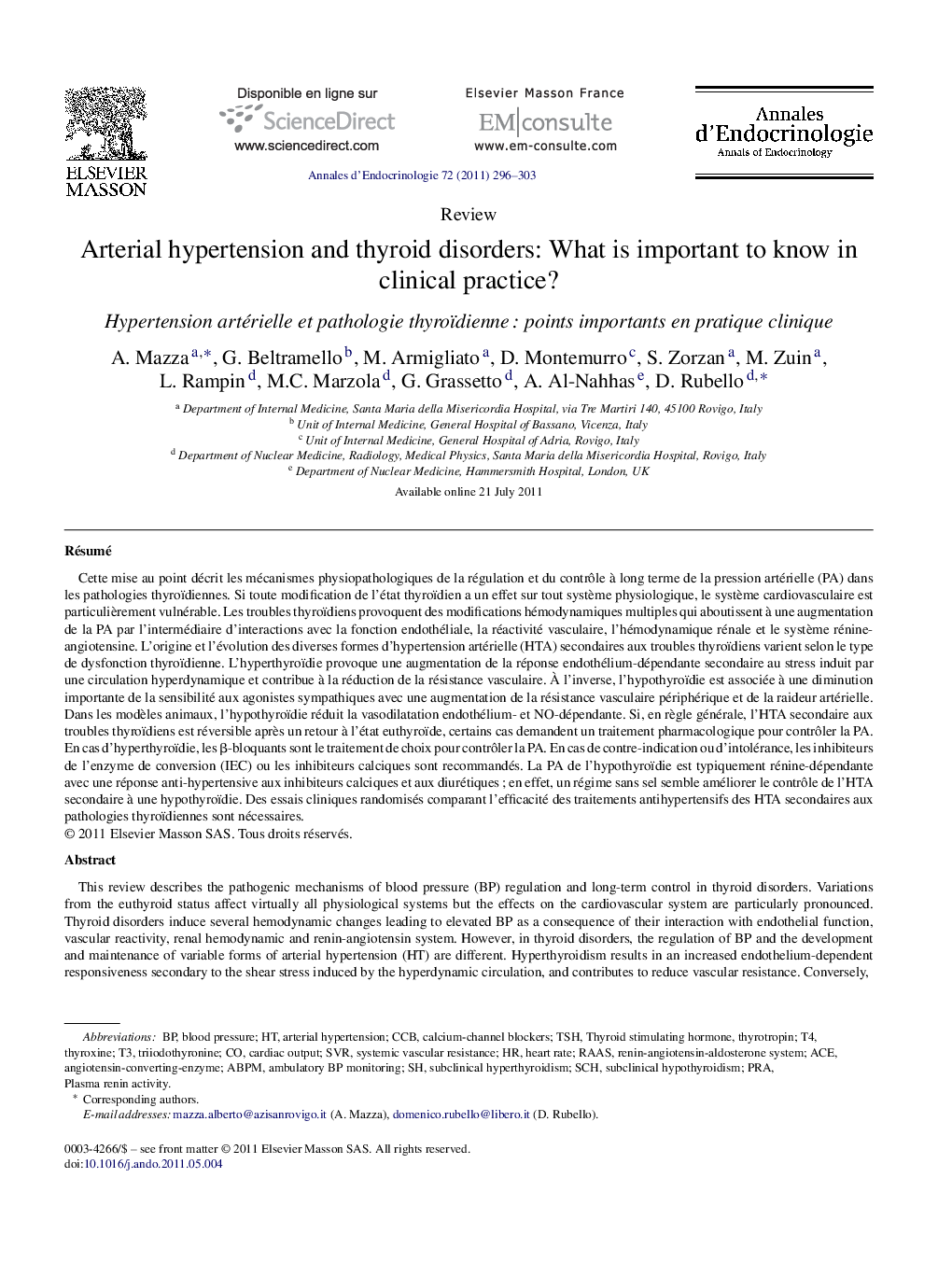| کد مقاله | کد نشریه | سال انتشار | مقاله انگلیسی | نسخه تمام متن |
|---|---|---|---|---|
| 3253073 | 1207095 | 2011 | 8 صفحه PDF | دانلود رایگان |

RésuméCette mise au point décrit les mécanismes physiopathologiques de la régulation et du contrôle à long terme de la pression artérielle (PA) dans les pathologies thyroïdiennes. Si toute modification de l’état thyroïdien a un effet sur tout système physiologique, le système cardiovasculaire est particulièrement vulnérable. Les troubles thyroïdiens provoquent des modifications hémodynamiques multiples qui aboutissent à une augmentation de la PA par l’intermédiaire d’interactions avec la fonction endothéliale, la réactivité vasculaire, l’hémodynamique rénale et le système rénine-angiotensine. L’origine et l’évolution des diverses formes d’hypertension artérielle (HTA) secondaires aux troubles thyroïdiens varient selon le type de dysfonction thyroïdienne. L’hyperthyroïdie provoque une augmentation de la réponse endothélium-dépendante secondaire au stress induit par une circulation hyperdynamique et contribue à la réduction de la résistance vasculaire. À l’inverse, l’hypothyroïdie est associée à une diminution importante de la sensibilité aux agonistes sympathiques avec une augmentation de la résistance vasculaire périphérique et de la raideur artérielle. Dans les modèles animaux, l’hypothyroïdie réduit la vasodilatation endothélium- et NO-dépendante. Si, en règle générale, l’HTA secondaire aux troubles thyroïdiens est réversible après un retour à l’état euthyroïde, certains cas demandent un traitement pharmacologique pour contrôler la PA. En cas d’hyperthyroïdie, les β-bloquants sont le traitement de choix pour contrôler la PA. En cas de contre-indication ou d’intolérance, les inhibiteurs de l’enzyme de conversion (IEC) ou les inhibiteurs calciques sont recommandés. La PA de l’hypothyroïdie est typiquement rénine-dépendante avec une réponse anti-hypertensive aux inhibiteurs calciques et aux diurétiques ; en effet, un régime sans sel semble améliorer le contrôle de l’HTA secondaire à une hypothyroïdie. Des essais cliniques randomisés comparant l’efficacité des traitements antihypertensifs des HTA secondaires aux pathologies thyroïdiennes sont nécessaires.
This review describes the pathogenic mechanisms of blood pressure (BP) regulation and long-term control in thyroid disorders. Variations from the euthyroid status affect virtually all physiological systems but the effects on the cardiovascular system are particularly pronounced. Thyroid disorders induce several hemodynamic changes leading to elevated BP as a consequence of their interaction with endothelial function, vascular reactivity, renal hemodynamic and renin-angiotensin system. However, in thyroid disorders, the regulation of BP and the development and maintenance of variable forms of arterial hypertension (HT) are different. Hyperthyroidism results in an increased endothelium-dependent responsiveness secondary to the shear stress induced by the hyperdynamic circulation, and contributes to reduce vascular resistance. Conversely, hypothyroidism is accompanied by a marked decrease in sensitivity to sympathetic agonists with an increase of peripheral vascular resistance and arterial stiffness. Furthermore in animal models, hypothyroidism reduces the endothelium-dependent and nitric oxide-dependent vasodilatation. HT due to thyroid disorders is usually reversible with achievement of euthyroidism, but in some cases pharmacological treatment for BP control is required. In hyperthyroidism, β-blockers are the first-choice treatment to control BP but when they are contraindicated or not tolerated, ACE-inhibitors or calcium-channel blockers (CCB) are recommended. Hypothyroidism is a typical low rennin HT form showing a better antihypertensive response to CCB and diuretics; indeed in hypothyroidism a low-sodium diet seems further to improve BP control. Randomized clinical trials to compare the efficacy on BP control of the antihypertensive treatment in thyroid disorders are needed.
Journal: Annales d'Endocrinologie - Volume 72, Issue 4, September 2011, Pages 296–303